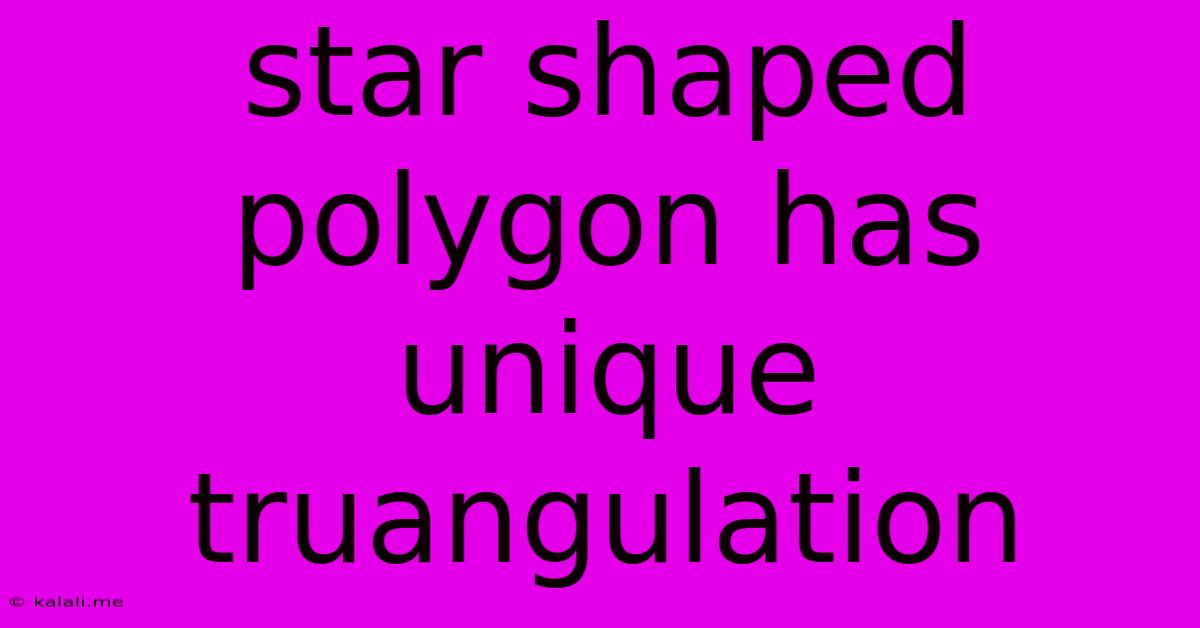Star Shaped Polygon Has Unique Truangulation
Kalali
May 24, 2025 · 3 min read

Table of Contents
The Unique Triangulation of Star-Shaped Polygons
Meta Description: Discover the fascinating mathematical property of star-shaped polygons: their unique triangulation. Learn about the implications of this unique characteristic and explore its applications in various fields. This article delves into the definition, properties, and proofs related to this intriguing geometric concept.
Star-shaped polygons possess a unique and intriguing property: they have a unique triangulation. This means that there's only one way to divide the polygon into triangles using only its vertices. This seemingly simple fact has profound implications in computational geometry, computer graphics, and other areas requiring efficient polygon decomposition. This article explores this unique property, delving into its definition, properties, and why it holds true.
What is a Star-Shaped Polygon?
Before exploring the unique triangulation, it's crucial to understand what constitutes a star-shaped polygon. A polygon is considered star-shaped if there exists at least one point within the polygon (called the kernel) such that every vertex of the polygon is visible from this point. "Visible" means that the line segment connecting the kernel to any vertex lies entirely within the polygon. This contrasts with other polygons where such a kernel point might not exist. Think of a simple star; you can find a central point from which all points of the star are visible. A simple convex polygon is also star-shaped, as any interior point will work as a kernel.
The Uniqueness of Triangulation
The triangulation of a polygon involves dividing it into triangles using only its vertices as the vertices of the triangles. For most polygons, multiple triangulations are possible. However, star-shaped polygons defy this generality. The key to understanding the uniqueness lies in the existence of the kernel.
Because every vertex is visible from the kernel, we can construct a unique triangulation by connecting each vertex to the kernel. This creates a set of triangles, each sharing the kernel as a common vertex. This method ensures that all the triangles lie entirely within the polygon and utilizes only the vertices of the original star-shaped polygon. No other triangulation is possible without introducing additional vertices or lines that extend beyond the polygon's boundaries.
Proof of Unique Triangulation
While a rigorous mathematical proof requires advanced concepts from graph theory and computational geometry, we can intuitively understand the uniqueness. Any attempt to triangulate a star-shaped polygon differently from the kernel-based method would inevitably lead to one of the following:
- Intersecting lines: Attempting to connect vertices in a way that differs from the kernel-based method would necessarily create intersecting lines within the polygon, which is not allowed in a valid triangulation.
- Triangles outside the polygon: Alternative connections could result in triangles that extend beyond the polygon's boundaries, again violating the rules of triangulation.
Implications and Applications
The unique triangulation property of star-shaped polygons has significant practical implications:
- Computational Geometry: Algorithms for polygon decomposition and mesh generation often benefit from this property, leading to more efficient and predictable results.
- Computer Graphics: In rendering and animation, representing complex shapes as a collection of triangles simplifies calculations. The unique triangulation ensures consistency and simplifies processing.
- Image Processing: Techniques involving polygon analysis and shape recognition can leverage the uniqueness of triangulation for faster and more reliable results.
Conclusion
The unique triangulation of star-shaped polygons is a remarkable property with far-reaching consequences in various fields. Understanding this property highlights the subtle interplay between geometry and computation, offering valuable insights into efficient algorithms and practical applications. The existence of the kernel point acts as the keystone that guarantees this unique decomposition, simplifying complex problems into more manageable forms. Further exploration of this topic could delve into specific algorithms for triangulation and the complexities involved in identifying the kernel of more intricate star-shaped polygons.
Latest Posts
Latest Posts
-
What Is 20 Percent Of 800 000
Jul 12, 2025
-
Words That Start With Y In Science
Jul 12, 2025
-
Prevent An Expressway Emergency By Merging Without
Jul 12, 2025
-
How Many Grams Of Sugar In A Pound
Jul 12, 2025
-
7am To 11am Is How Many Hours
Jul 12, 2025
Related Post
Thank you for visiting our website which covers about Star Shaped Polygon Has Unique Truangulation . We hope the information provided has been useful to you. Feel free to contact us if you have any questions or need further assistance. See you next time and don't miss to bookmark.